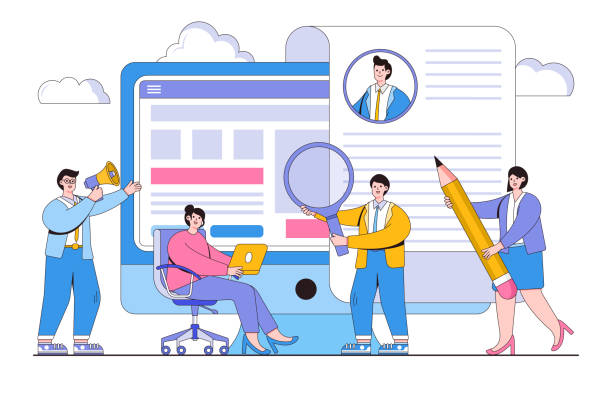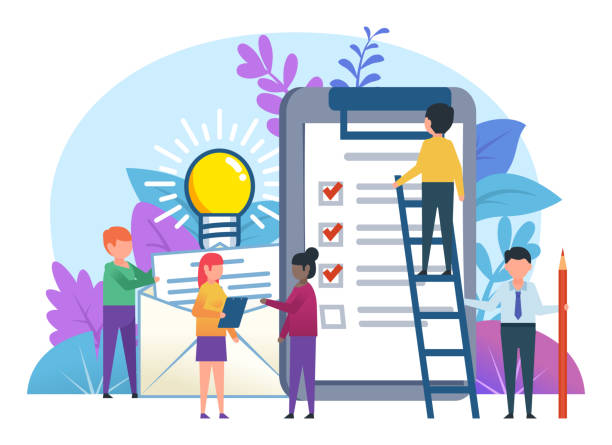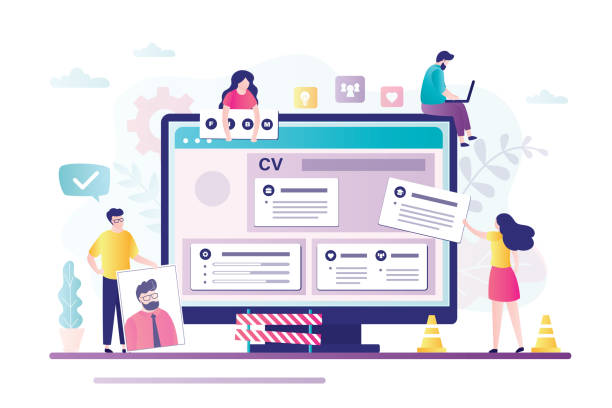The Importance of Fast Website Design in Today’s World

In the current digital age, speed is paramount, and #site_speed is no longer an option but an undeniable necessity.
When we speak of fast website design, we don’t just mean quick page loading, but also providing an exceptional #user_experience and optimization for search engines.
Internet users have little patience; studies show that if a website doesn’t load within 2 to 3 seconds, a significant portion of visitors will abandon it.
This phenomenon, known as a high “Bounce Rate,” not only eliminates business opportunities but also harms your site’s ranking in search results.
Fast website design means ensuring easy and delayed access to information, which in turn increases customer loyalty.
In fact, the faster your website is, the more likely users are to stay on it, interact with content, and ultimately convert into customers.
This is particularly vital for online stores and sites that publish #analytical or #news content.
High website speed not only helps improve SEO ranking but also reduces advertising costs, as more users view and interact with the site without the need for repeated campaigns.
Therefore, any investment in fast website design is a significant step towards long-term success in the digital space.
Are you tired of your e-commerce website not generating as much revenue as it could? RasaWeb, an expert in professional e-commerce website design, solves this problem permanently!
✅ Increase sales rate and revenue
✅ High loading speed and unparalleled user experience
⚡ Get free consultation for e-commerce website design
Key Benefits of Speed for Your Website

Fast website design is not just a technical feature; it’s a comprehensive strategy that directly impacts User Experience (UX), Search Engine Optimization (SEO), and Conversion Rate.
The first and perhaps most important benefit is improved user experience.
When a site loads quickly, users feel satisfied and are more likely to stay on the site and browse more pages.
This leads to a reduced bounce rate and increased user session duration, both of which are positive signals for Google’s algorithms.
The second benefit is the direct impact on SEO.
Google has explicitly stated that site speed is a ranking factor.
Faster sites achieve higher rankings in search results, meaning they will attract more organic traffic.
This is a #specialized topic whose importance is growing daily.
The third and perhaps most vital benefit for businesses is an increased conversion rate.
For example, an online store whose product pages load quickly is more likely to generate more sales because users do not encounter delays in the purchasing process.
This is a clear explanation of the direct link between speed and profitability.
Additionally, high speed saves on server and bandwidth costs because fewer resources are consumed to serve each user.
This technical optimization will lead to significant long-term return on investment.
Therefore, investing in fast website design means investing in the sustainable growth and success of your business.
Technical Infrastructure for Fast Website Design

To achieve fast website design, special attention must be paid to the technical infrastructure.
The first and most important part is choosing the right hosting.
Poor hosting, even with the best coding, can severely slow down your site.
Options such as Cloud Hosting or Dedicated Servers usually offer better performance than shared hosting, although they also come with a higher cost.
In addition to hosting, using a Content Delivery Network (CDN) is a #specialized and highly effective step.
A CDN stores your site’s static files (like images, CSS, and JavaScript) on multiple servers worldwide and selects the closest server to the user for content delivery, which significantly increases loading speed.
Furthermore, image optimization is of high importance.
Large images are one of the most common causes of slow sites.
Using appropriate image formats (like WebP), compressing images without significant quality loss, and implementing “Lazy Loading” for images can have a tremendous impact on site speed.
These measures are key guidelines for anyone looking for fast website design.
Comparison of Hosting Types for Website Speed
| Hosting Type | Advantages | Disadvantages | Suitable For |
|---|---|---|---|
| Shared Hosting | Cheap, easy setup | Variable performance, limited resources, slower speed | Personal websites, small blogs |
| Virtual Private Server (VPS) | Dedicated resources, more flexibility | Requires technical knowledge, more expensive than shared | Medium websites, small online stores |
| Cloud Hosting | High scalability, excellent stability and speed | Higher cost based on consumption | Large, high-traffic websites, e-commerce |
| Dedicated Server | Full control, maximum performance and security | Most expensive, requires high technical knowledge | Large companies, critical platforms |
Code Optimization and Caching for More Speed

In addition to hardware and network infrastructure, fast website design requires precise code optimization and intelligent use of caching mechanisms.
The first step in this area is minification of HTML, CSS, and JavaScript files.
This process involves removing extra characters such as white spaces, tabs, comments, and new lines from the code, which significantly reduces file size without affecting performance.
The smaller the size of files sent to the user’s browser, the faster the loading speed will be.
The second important step is implementing caching mechanisms.
Caching allows browsers and servers to store copies of site files for subsequent access.
Browser Caching stores files like images, CSS, and JavaScript on the user’s device, so they don’t need to be re-downloaded on subsequent visits.
Server-side Caching also keeps database query results or entire pages in the server’s memory, causing subsequent requests to be responded to much faster.
Using Content Management Systems (CMS) like WordPress with powerful caching plugins is a practical and effective guideline.
These #specialized measures not only increase loading speed but also reduce server load and contribute to greater site stability.
Don’t have a corporate website yet and missing out on online opportunities? By designing a professional corporate website through RasaWeb,
✅ Double your business’s credibility
✅ Attract new customers
⚡ Free consultation for your corporate website!
Content and Its Impact on Speed and User Interaction

Content is king, but in the world of fast website design, heavy content can challenge that reign.
This is a questionable content point of how to strike a balance between rich content and high speed.
While high-quality images and videos are essential for attracting users’ attention and conveying messages better, if not properly optimized, they can severely reduce website loading speed.
For example, a web page with multiple embedded videos or very high-resolution images may take a long time to fully load, which harms user experience and increases the bounce rate.
The solution to this challenge lies in content optimization.
Using appropriate compression for images and videos, selecting optimized formats (such as WebP for images and HEVC compression for videos), and employing “Lazy Loading” for content that is not initially visible on the user’s screen are among these solutions.
Additionally, streaming videos from services like YouTube or Vimeo instead of direct hosting relieves the load on your site’s server.
This explanation shows that high-quality content does not necessarily mean heavy content.
By implementing these strategies, you can ensure your site is both engaging and fast, which in turn leads to greater user interaction and success in fast website design.
Tools and Metrics for Website Speed Measurement

To ensure your fast website design is properly implemented, you need accurate tools for measuring and monitoring speed.
Fortunately, powerful educational tools are available to help you evaluate your site’s performance and identify its weaknesses.
One of the most popular tools is Google PageSpeed Insights, which gives you a speed score for mobile and desktop devices and provides optimization suggestions.
Another widely used tool is GTmetrix, which offers detailed information on the loading of each page component, full load time, and performance grades.
Google Lighthouse is also a specialized and automated tool for auditing webpage quality that evaluates accessibility, best practices, and SEO in addition to speed.
The most important metrics measured by these tools include Core Web Vitals: Largest Contentful Paint (LCP) which measures the loading time of the largest visual element on the page, First Input Delay (FID) which indicates the site’s responsiveness to the user’s first interaction, and Cumulative Layout Shift (CLS) which assesses the visual stability of the page.
By regularly monitoring these metrics, you can ensure continuous optimization of your site’s speed and provide a better user experience, which leads to success in fast website design.
Common Mistakes in Fast Website Design and Solutions
![]()
Even with the best intentions, some common mistakes can hinder the achievement of fast website design.
Identifying and avoiding these mistakes is essential for any developer and business owner.
One of the most common errors is using large, unoptimized images.
As mentioned earlier, uncompressed images can significantly slow down loading times.
Solution: Always optimize images before uploading and use modern formats like WebP.
Another mistake is inefficient coding or using too many plugins in CMSs.
Many themes and plugins have unnecessary JavaScript and CSS code that increase page load.
Solution: Remove or minify unnecessary code and only use plugins you truly need.
The third mistake is not using proper caching.
Without caching, every time a user visits your site, the server has to load all information from scratch.
Solution: Install powerful caching plugins for your CMS or enable server-side caching.
The fourth mistake is choosing inappropriate and weak hosting.
Solution: When choosing hosting, do not sacrifice quality for price, and select a provider that matches your site’s needs and traffic.
This section is an analysis of common problems and practical guidelines to address them.
By observing these points, you can effectively improve your site’s speed and prevent unnecessary slowdowns, which significantly contributes to the fast website design process.
Common Mistakes in Speed Optimization and Solutions
| Common Mistake | Impact on Speed | Recommended Solution |
|---|---|---|
| Unoptimized images | Increased load time, high bandwidth consumption | Compression, resizing, using WebP format, Lazy Loading |
| Excessive and unorganized CSS/JS code | Increased file size, blocking page rendering | Minification, file concatenation, asynchronous loading |
| Lack of caching | Full page reloads on every visit | Enable browser and server caching, use caching plugins |
| Weak or inappropriate hosting | Resource limitations, slow server response | Upgrade to cloud hosting or VPS, choose a reputable provider |
| Excessive use of plugins/extensions | Increased HTTP requests, site sluggishness | Remove unnecessary plugins, use coding solutions instead of plugins |
Future Trends in Web Speed Optimization

The world of the web is constantly evolving, and with it, the standards of fast website design are advancing.
Awareness of future news and analytical trends helps you prepare your site for future challenges.
One of the most important upcoming trends is Google’s Mobile-First Indexing.
This means Google will primarily examine your site’s mobile version for ranking.
Therefore, site speed and performance on mobile devices have become even more critical than on desktop.
Responsive Design and optimization for touch devices are of high importance.
Another trend is the emergence of Progressive Web Apps (PWAs).
PWAs offer a native app-like experience in the browser, including capabilities such as offline functionality, push notifications, and very fast loading.
This technology heavily focuses on speed and user interaction.
Additionally, with the introduction of new network protocols like HTTP/3 built on QUIC, data transfer speeds on the web are expected to improve significantly.
This protocol is optimized for unstable connections and mobile devices, reducing latency.
In the future, we will also see a greater emphasis on Serverless Computing, which provides greater scalability and speed.
These developments indicate that fast website design is a dynamic field that constantly requires knowledge and continuous updates.
Did you know that a weak corporate website loses many opportunities daily? Solve this problem permanently by designing a professional corporate website with RasaWeb!
✅ Create a powerful and trustworthy brand image for your business
✅ Attract new target customers and increase sales
⚡ [Get free website design consultation]
Choosing the Best Approach for Fast Website Design

To achieve fast website design, choosing the right approach is crucial.
This choice depends on your resources, technical knowledge, and project complexity.
There are two main paths ahead: doing it yourself (DIY) or hiring a specialist.
If you have a limited budget and are willing to learn, using Content Management Systems (CMS) like WordPress with optimized themes and plugins is an excellent guideline.
WordPress alone offers many options for speed optimization, including caching and image compression plugins.
This approach allows you to have an acceptable site with good speed at a lower cost.
However, if you are looking for a completely specialized and customized solution, or if your project has many technical complexities, hiring a web designer or web development company is a better option.
Specialists can optimize your site’s code from scratch, implement the best database structure, and leverage the latest technologies for speed optimization.
They can also help you choose suitable hosting and configure a CDN.
This explanation of available paths helps you make a decision based on your specific needs.
Regardless of the chosen approach, the ultimate goal should always be to achieve a website with high loading speed that provides both an excellent user experience and is SEO-optimized.
Success Stories of Fast Website Design

To fully understand the importance of fast website design, nothing is better than reviewing real success stories.
This entertaining yet analytical section shows how various businesses have achieved significant results by focusing on web speed.
For example, a large online retail company reported that by reducing their page load time by just 0.1 seconds, they increased their customer conversion rate by 1%.
This 1% increase in sales translated into millions of dollars in additional annual revenue for them.
This example clearly shows that even minor improvements in speed can have enormous financial impacts.
In another example, a high-traffic news website, after optimizing site speed and reducing load time to less than 2 seconds, saw a 20% increase in the number of page views per user and a 10% increase in its advertising revenue.
This indicates that users not only enjoy faster sites but also tend to consume more content.
Even large companies like Google and Amazon are constantly optimizing their site speeds, knowing that every millisecond matters for user experience and ultimately for their business.
These stories confirm that investing in fast website design is a smart and rewarding investment for any business of any scale.
Frequently Asked Questions
| Row | Question | Answer |
|---|---|---|
| 1 | What is fast website design? | Fast website design refers to the process of launching a functional and optimized website in the shortest possible time, without sacrificing quality or efficiency. |
| 2 | What factors influence website design speed? | Using ready-made Content Management Systems (CMS) like WordPress, optimized ready-made templates, visual design tools, designer’s experience, and effective client communication. |
| 3 | Does fast website design always mean reduced quality? | No, with proper planning, using optimized tools, and standard techniques, a high-quality website can be designed in a short time. |
| 4 | What types of websites are best suited for fast design? | Small corporate websites, blogs, online resumes, landing pages, and online stores with limited products. |
| 5 | What is the role of CMSs (like WordPress) in fast design? | CMSs significantly accelerate the design and development process by providing themes, plugins, and an easy-to-use administration panel. |
| 6 | Does fast website design cost less? | Usually yes. Due to reduced designer working time and the use of ready-made resources, costs can be significantly reduced. |
| 7 | What information is needed from the client for fast design? | Contact information, logo, textual content, images, website goals, and any specific customization needs. |
| 8 | Can fast-designed websites be developed in the future? | Yes, especially if built with popular CMSs like WordPress, new features can be easily added in the future. |
| 9 | What are the benefits of fast website design for businesses? | Faster market entry, testing new ideas with minimal risk, reduced costs, and the ability to launch immediate marketing campaigns. |
| 10 | What is the difference between fast website design and a “ready-made website”? | Fast design involves a design and implementation process based on client needs, although it uses ready-made tools. However, a “ready-made website” usually refers to platforms where you simply input your information and receive a pre-defined site. |
And other services of RasaWeb advertising agency in the field of advertising
Smart UI/UX: A fast and efficient solution for analyzing customer behavior with a focus on Google Ads management.
Smart Social Media: A creative platform for improving customer behavior analysis with custom programming.
Smart Brand Identity: An innovative service for increasing website traffic through custom programming.
Smart Website Development: A professional solution for online growth with a focus on SEO-driven content strategy.
Smart Data Analysis: A creative platform for improving campaign management using real data.
And over a hundred other services in the field of internet advertising, advertising consulting, and organizational solutions
Internet Advertising | Advertising Strategy | Advertorials
Resources
- Importance and Methods to Increase Website Speed
- Why Website Speed is Crucial for Businesses
- 15 Methods for Designing a Fast Website
- The Importance of Website Speed in User Experience and SEO
? RasaWeb Afarin, a specialist in digital marketing solutions, helps your business achieve its goals. We are your best partner for success in the digital world in WordPress website design, SEO optimization, social media management, and online advertising campaigns. Contact us today for a free consultation and to learn about our services!
📍 Tehran, Mirdamad Street, next to Bank Markazi, Kazeroon Jonubi Alley, Ramin Alley, P. 6




